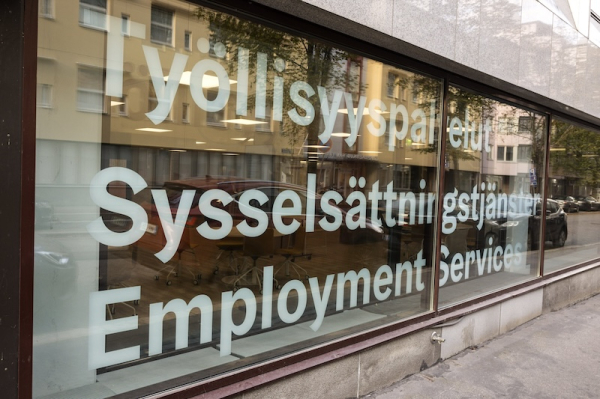Finland’s unemployment rate reaches highest level since records began

Employment Service office in Helsinki. Photo: Roni Rekomaa / Lehtikuva
- Previous Article Government considers ban on face coverings in public spaces
- Next Article Milan Jaff hires ex-murder convict as legal advisor in deportation case
Finland’s unemployment rate has climbed to 10 percent, marking the highest trend figure recorded since current labour force statistics began in 2009. According to Statistics Finland, there were 267,000 unemployed persons in August, an increase of 53,000 from the same time last year.
The trend-based unemployment rate, which filters out seasonal and irregular fluctuations, has steadily increased since spring 2023, when it stood at 6.8 percent. The current level reflects prolonged weakness in the labour market and growing concern among economists and policymakers.
“The current figure is unprecedented in the current statistical series,” said Joanna Viinikka, Senior Statistician at Statistics Finland.
The unadjusted unemployment rate for August was 9.3 percent, up from 7.5 percent a year earlier. Long-term unemployment also continues to rise. More than 129,000 people have been without work for over 12 months, 32,000 more than in August 2022, according to data from the Centre for Economic Development, Transport and the Environment (ELY).
The most significant rise in long-term unemployment has occurred in the capital region. In Uusimaa, the number of unemployed people under 30 who have been jobless for over a year has grown by more than 63 percent compared to last year.
Economists describe the situation as critical. Roope Ohlsbom, economist at the Federation of Finnish Enterprises, said: “Unemployment is rising while the number of open positions is falling. This makes re-employment harder.”
Jukka Appelqvist, Chief Economist at the Finland Chamber of Commerce, called the August figures “a bitter disappointment”. He added that economic recovery is not materialising, and prolonged stagnation is now translating into widespread unemployment.
Henna Busk, Senior Economist at Pellervo Economic Research, noted a troubling trend among younger jobseekers. “Starting a career during a downturn can have long-term negative effects on income and career progression, and it increases the risk of marginalisation,” she said.
Finland’s population now includes over one million people aged 70 and over. This demographic shift adds structural pressure to the labour market and welfare systems. People aged 70 and above now make up 18 percent of the population, compared to 9 percent in the early 1990s. According to Statistics Finland, 568,000 of the over-70s are women and 432,000 are men.
“Declining mortality and rising life expectancy have enabled this growth,” said Joonas Toivola, Senior Actuary at Statistics Finland.
While the ageing population is a long-term issue, more immediate political focus has turned to the government’s response to unemployment. The Centre Party announced plans to submit a motion of no confidence in Prime Minister Petteri Orpo’s government, citing its failure to reverse the deteriorating labour market.
“This cannot go on,” said Antti Kaikkonen, Centre Party leader. “Something must be done, or the human and economic consequences for Finland will be irreversible.”
Kaikkonen proposed restoring the €300 earnings disregard on unemployment benefits and increasing the household expenses tax credit. The current government removed the €300 allowance earlier this year, meaning that even small amounts of work now reduce unemployment support payments.
Finland’s population has increased by 14,354 people between January and August this year, largely due to immigration. During that time, the number of immigrants exceeded the number of emigrants by 23,003. However, births were 8,679 fewer than deaths, underlining a broader demographic challenge.
Statisticians warn that while immigration has offset population decline in urban centres, many rural municipalities face significant shrinkage over the next two decades, driven by ageing and falling birth rates.
The largest age group in Finland is currently those aged 30–34. Without immigration, the largest cohort would be people born in 1963.
HT
- Previous Article Government considers ban on face coverings in public spaces
- Next Article Milan Jaff hires ex-murder convict as legal advisor in deportation case
Source: www.helsinkitimes.fi
